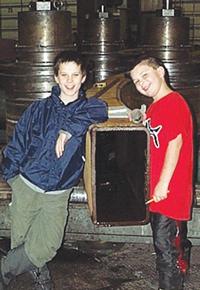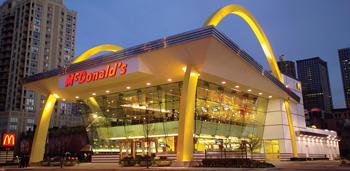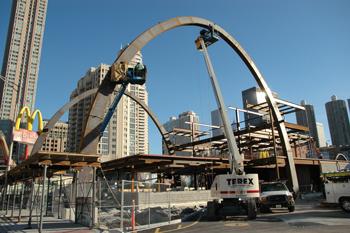Contributing Writer
- FMA
- The Fabricator
- FABTECH
- Canadian Metalworking
Categories
- Additive Manufacturing
- Aluminum Welding
- Arc Welding
- Assembly and Joining
- Automation and Robotics
- Bending and Forming
- Consumables
- Cutting and Weld Prep
- Electric Vehicles
- En Español
- Finishing
- Hydroforming
- Laser Cutting
- Laser Welding
- Machining
- Manufacturing Software
- Materials Handling
- Metals/Materials
- Oxyfuel Cutting
- Plasma Cutting
- Power Tools
- Punching and Other Holemaking
- Roll Forming
- Safety
- Sawing
- Shearing
- Shop Management
- Testing and Measuring
- Tube and Pipe Fabrication
- Tube and Pipe Production
- Waterjet Cutting
Industry Directory
Webcasts
Podcasts
FAB 40
Advertise
Subscribe
Account Login
Search
Curving out a niche
Chicago fabricator helps McDonald's mark milestone, reaches one of its own
- By Michael Bishop
- April 15, 2008
- Article
- Tube and Pipe Fabrication
In celebration of its 50th anniversary in April 2005, McDonald's® opened a 24,000-square-foot restaurant in Chicago. The fast-food chain wanted to highlight both its past and its future, and to that end the restaurant features the red and white colors of founder Ray Kroc's first building, Wi-Fi capability on both floors, a garden, and a two-lane drive-through. Fifty years' worth of McDonald's memorabilia, S-shaped chairs, and a Brazilian granite counter give visitors plenty to ogle while downing their cheeseburgers and fries.
The restaurant's most eye-catching feature, however, is a pair of parabolic arches that stand 60 feet high. The arches, constructed from 20-inch by 12-in. tubes, were curved by Chicago Metal Rolled Products, an OEM component subcontractor. Employing 75 workers, 60 of them in its 100,000-sq.-ft. shop, the company curves steel parts for railroad cars, antennae, wind turbines, and agricultural and construction equipment.
Chicago Metal Rolled Products got involved with the project during Thanksgiving week of 2004. Tefft Bridge & Iron LLC (TBI), Wheatfield, Ind., served as the structural steel fabricator and erector of the building. The company was in a bind for time and contacted Chicago Metal. The two companies had teamed up on past projects, including the Monroe Street Bridge in Chicago, and since have worked together on steel mill parts.
"The material came in on Tuesday," Chicago Metal President George Wendt said. "We rolled Wednesday, Friday, and Saturday."
According to Jim Szymusiak, TBI vice president, the arches drove construction of the restaurant, which had to be finished and ready to open by April 15, 2005, for the McDonald's anniversary celebration. The arches were made in four pieces, with each piece consisting of two ASTM Grade 50 tubes and a plate on the front and back. The operation was a just-in-time (JIT) project, with TBI erecting the sections at the job site as soon as Chicago Metal supplied the curved tubes. Both companies worked on the arches for most of the Thanksgiving weekend, finishing them in days.
"I think we had time to just wolf down some dressing, and that was it," Szymusiak said.
The Easy Way or the Hard Way
Wendt said the tubes Chicago Metal used for the arches are the largest made. The company used an R13S bending machine from Roundo—modified for applications Chicago Metal regularly encounters—to bend the tubes in what's known as the easy way, or against the weak (Y-Y) axis. This actually proved more challenging than the alternative. Despite the name, bending the hard way actually is easier, Wendt explained. Bent on the X-X axis, the tube maintains its shape and has a reduced chance of deformation, whereas tubes bent the easy way tend to become concave along the inside of the curve.
"If you have a straw, for example, and you try to bend it, it's going to want to kink," Wendt said. "The trick is to bend it and still maintain the dimensional tolerances."
Addition by Subtraction
After looking at the plans, somebody told McDonald's that the arches couldn't be built as originally drawn, according to Szymusiak. TBI disagreed, even though the company had never attempted a similar project before.
Chicago Metal offered a suggestion that improved the original design. Weld splices are particularly expensive when they have to be done at the job site, Wendt said. They also reduce the amount of control the erector has over the finished product. If the arches were done in short sections with different bend radii, then the project would require shorter sections of tube, making it tougher to establish a true parabola.
To address this problem, Chicago Metal used longer pieces of tube, making multiple bends in each. The benefit was twofold: It not only increased the accuracy of the parabola, but also significantly reduced the number of weld splices and parts needed to complete the job.
"We saved our customer eight splices," Wendt said. "Eight expensive, full-penetration weld splices."
The top of the arches required a 22.9-ft. bend radius, which was much tighter than the sides and at the time was probably the tightest bend that could be done cold, according to George's son, Dan Wendt, a Chicago Metal engineer and project manager.
"The other alternative was to build it up out of plates or [to] heat it up and bend it," Dan said. "I think other people could've done it, but they couldn't do the top. We did the part without [using] heat."
Form and Function
As the erector, TBA did have to make some full-penetration welds at the job site. The arches required only three, however: one at the peak, and the other two on the left and right sides. The company even found time to work in a prank on McDonald's. As the crew was placing the second arch, one of them snapped a picture when the structure was about a foot off from its required location relative to the other arch. The company then sent the photo to the McDonald's headquarters in Oak Brook, Ill., with a message that they were stuck and needed suggestions. Szymusiak said the office was in an uproar about the problem for a few minutes until he informed them of the joke.
Construction wrapped up on schedule; the restaurant opened on time. When the arches were finished, they fulfilled a functional duty in addition to an aesthetic one. Erected to protrude through the roof, they contribute to the structure of the building. What did McDonald's think of the finished restaurant, especially after ending up on the receiving end of TBI's joke?
"If it means anything, they invited my wife and me to their 50th anniversary party," Szymusiak said.
Tight tolerances on the bends. A JIT project scheduled around a holiday. A narrow time frame for completion. An opening date set in stone. Things could have gotten extremely tense as TBI and Chicago Metal scrambled to finish the job, but their working relationship and familiarity with their collective capabilities kept the operation moving. TBI cited the long tubes with more bends and fewer splices as a key to the project's success.
"Chicago Metal Rolled did step up to the plate, and in crunch time they did an excellent job," Szymusiak said.
Tradition Rolls Along
Chicago Metal has reached a milestone of its own. This year the company is celebrating its 100th anniversary. Founded as Chicago Metal Manufacturing Co., the business renamed itself in 1984. In 2004 it opened a rolling facility in Kansas City, Mo., to service its customers west of the Mississippi.

Chicago Metal engineer Dan Wendt's sons stand next to a curved tube used for the arches. The company bent the tubes the easy way, against the weak axis.
Considering how long Chicago Metal has been in business, did the McDonald's arches present challenges that the company had never faced before?
"We had never rolled these tubes into a parabola before," George Wendt said. "We found out that we could do these pretty well; that there was minimal distortion; that we could do them fast. It was a little bit of a risky project, but something that gave us more confidence that we could go on and tackle other difficult projects and compete with anyone on how quickly we can do this."
The downtown Chicago restaurant was intended to showcase McDonald's past and look ahead to its future, the chain told the Chicago Tribune in 2004. The arches contributed the most prominent feature of a building designed with many. At the same time, the project showed Chicago Metal Rolled Products that even after a century of experience, it still can learn something new about its own capabilities. The company has since put the knowledge to use by developing technologies that allow even tighter bends.
About the Author

Related Companies
subscribe now

The Fabricator is North America's leading magazine for the metal forming and fabricating industry. The magazine delivers the news, technical articles, and case histories that enable fabricators to do their jobs more efficiently. The Fabricator has served the industry since 1970.
start your free subscription- Stay connected from anywhere

Easily access valuable industry resources now with full access to the digital edition of The Fabricator.

Easily access valuable industry resources now with full access to the digital edition of The Welder.

Easily access valuable industry resources now with full access to the digital edition of The Tube and Pipe Journal.
- Podcasting
- Podcast:
- The Fabricator Podcast
- Published:
- 04/16/2024
- Running Time:
- 63:29
In this episode of The Fabricator Podcast, Caleb Chamberlain, co-founder and CEO of OSH Cut, discusses his company’s...
- Trending Articles
AI, machine learning, and the future of metal fabrication

Employee ownership: The best way to ensure engagement

Steel industry reacts to Nucor’s new weekly published HRC price

Dynamic Metal blossoms with each passing year

Metal fabrication management: A guide for new supervisors

- Industry Events
16th Annual Safety Conference
- April 30 - May 1, 2024
- Elgin,
Pipe and Tube Conference
- May 21 - 22, 2024
- Omaha, NE
World-Class Roll Forming Workshop
- June 5 - 6, 2024
- Louisville, KY
Advanced Laser Application Workshop
- June 25 - 27, 2024
- Novi, MI





























